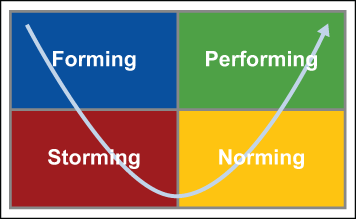For those who may not be aware of the stages of team development, let me share my personal experience with the more challenging stage called Storming. This is the stage that follows Forming (when a team forms, roles and processes can be unclear) and leads to Norming (where relationships and processes become clear and team process is optimized).

The Storming stage is exactly as it sounds – storm-like. It can be frustrating, confusing, the breeding ground for conflict and, contribute to being far less productive than a team that is in its high performing state.
As a consultant, I often get called in to help teams when they are facing some type of block – be it full on dysfunction or barriers to achieving their goals. I consider myself an ‘expert’ in this area given my range of skills, level of emotional intelligence and intuitive nature, and passion about group dynamics.
That does not mean I am immune to being impacted by the stages of development with my own team.
Last summer, I joined forces with a consulting firm. At that time, our firm was in startup mode. While our team members were each quite experienced, we still had to work through the painful forming and storming stages. Because we offer broad range of services, it was harder to quickly build and create integration points and have a shared brand and ‘face’ to our clients.
How has the storming phase been for me?
Frustrating, causing me to challenge myself and reflect on my values, encouraging me to develop more patience and tolerance of other working styles, challenging me to have difficult conversations and, ultimately growth. This experience affords each of my team members to ‘up’ our service to our clients because we can genuinely empathize with their plight of wearing all hats, trying to generate enough business to be successful, maintain relevance within the marketplace, distinguish their value proposition and build their brand.
Google’s Research on Teams
Passionate and curious about teams and team dynamics, I came across recent research Google did about “the perfect team”. Interestingly for them, their research took some time to highlight the ingredients that contribute to a perfect team’. It was not a simple recipe for success. The two key findings which caught my attention are:
Finding 1: The Right Norms
What the researchers found through assignments requiring different types of cooperation is that the only way to maximize a group’s score was for each person to sacrifice an item they really wanted for something the team needed. In other words, as Patrick Lencioni states in the Five Dysfunctions of a team, it’s really about focusing on the ‘collective result’ versus the individual result – what is best for our team and our organization, not what is best for me. What Google found is that teams who did well in one assignment did well in others, as they were bringing this attitude to how they approached the assignment and, conversely, teams that failed at one part of the assignment failed at everything. “What the researchers concluded was what distinguished ‘good’ teams from dysfunctional groups was how they treated one another. Therefore, “the right norms could raise a group’s collective intelligence, whereas the wrong norms could hobble a team, even if individually, all team members were exceptionally bright.”
I often refer to the concept of an orchestra. No matter how skilled each musician is, it’s the collective work of the musicians that create the music (i.e., focus on the collective result) and this is what leads to the beautiful masterpiece we are privileged to hear. If each musician tried to ‘top each other’ to be heard, to follow what they believed is the best way to play the musical piece and, if they ignored the cues of their conductor and each other, the output and quality would be compromised.
My question to myself and to each of us who are part of a team is:
- How have you been doing with putting the needs of your team over your individual needs?
- What can you be doing more of that will bring focus to the collective results of your team versus your individual needs?
- What barriers are you facing to move through the storming to norming?
- What conversations have you been avoiding that you need to have to form clarity and get clearer?
- What are you willing to ‘give up’ for the sake of your team?
- What are you not willing to give up?
Finding 2: Conversational Turn-Taking and Mutual Trust & Respect
The second finding that Google found is that bringing aspects of social sensitivity within a group culture will encourage team members to feel comfort in ‘interpersonal risk taking”. “Psychological safety is a sense of confidence that the team will not embarrass, reject or punish someone for speaking up,’’ Edmondson wrote in a study published in 1999. ‘‘It describes a team climate characterized by interpersonal trust and mutual respect in which people are comfortable being themselves.’’ Google refers to the ability of a team to have conversational turn-taking –and, most interestingly found that “psychological safety, more than anything was critical to making a team work’. This finding is reflected in both Covey’s “Speed of Trust” as well as Lencioni’s Five Dysfunctions of a team in that a team, to be high performing, needs the foundation of trust.
The questions that can guide us as we reflect on our team trust and psychological safety are:
- Do I feel safe and confident to speak my truth in my team?
- Am I cautious that if I speak my views on my team, I will be rejected, embarrassed or punished?
- What conversations do I need to have in order to create psychological safety in my team?
- What behaviours can I be doing that will encourage psychological safety for me as well as my team members?
- What’s at risk?
When I reflect on Google’s findings and consider my new team I am clear that the psychological safety within our team is good. We are respectful of one another; we encourage the diversity of viewpoints and have had difficult conversations emerge within our team meetings as well as between individual team members.
Where I believe our team can spend time to get closer to the perfect team is to create the ‘right norms’ so we are raising our collective intelligence as well as bringing our focus on the collective outcomes (versus our individual focus).
The quest for all of us is to consider our part, individually; we can each be doing to further the progress of the team we are a member of. Commitment means putting the focus on what’s best for the team versus self. As you prepare to close this blog, consider the following questions:
- How committed am I to my team and to the outcomes we’ve declared?
- How willing am I to call my individual team members on their behaviours that don’t align with the norms we have agreed to?
- What behaviours have I been doing that may have derailed my team from achieving its outcomes?
- What’s my non-negotiable that could have me leave this team?
- What am I willing to ‘sacrifice’ for the greater good of my team?
References:
Google’s Research on teams:
Patrick Lencioni’s Five Dysfunctions of a Team:
http://www.tablegroup.com/books/dysfunctions
Stephen Covey’s Speed of Trust:
http://www.speedoftrust.com/How-The-Speed-of-Trust-works/book



One Response
Hi Erica. Nice piece on team building. Content is very good. Style is warm and personal. Reads well. Thanks for doing this. EK and I are a productive team. We storm a lot. We work on norming. The rules we set in place for ourselves to be productive really help.
Hugs H